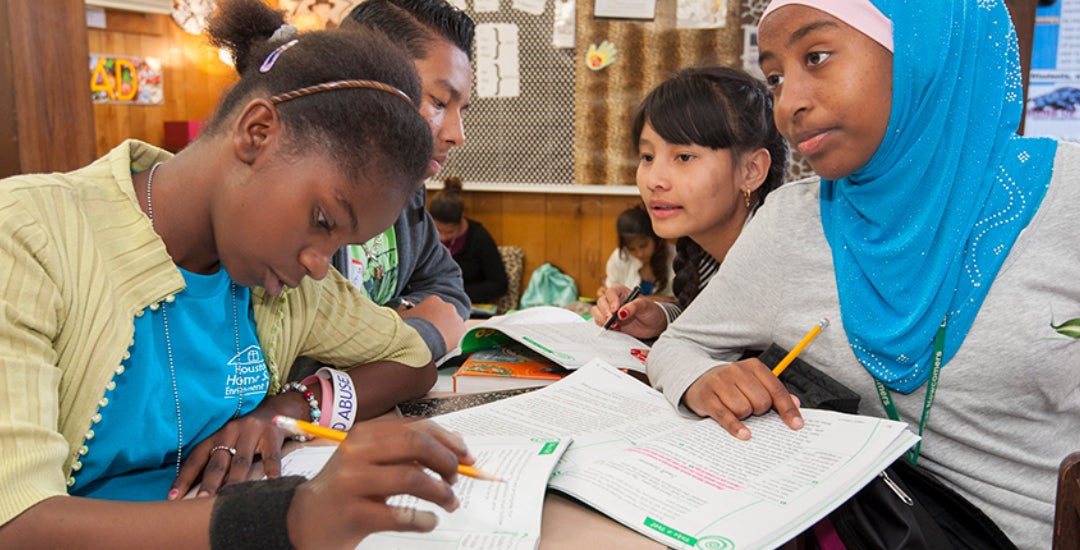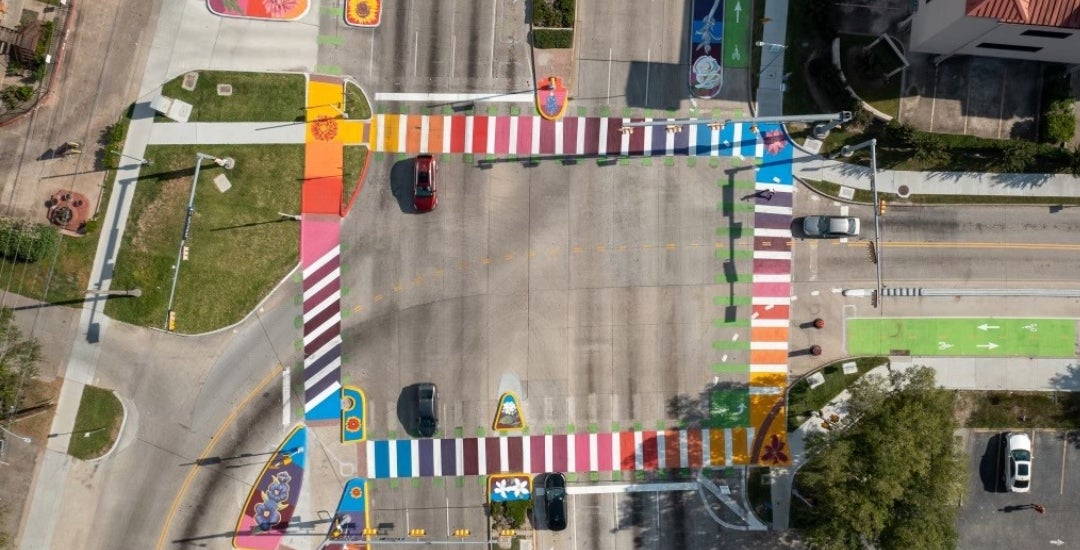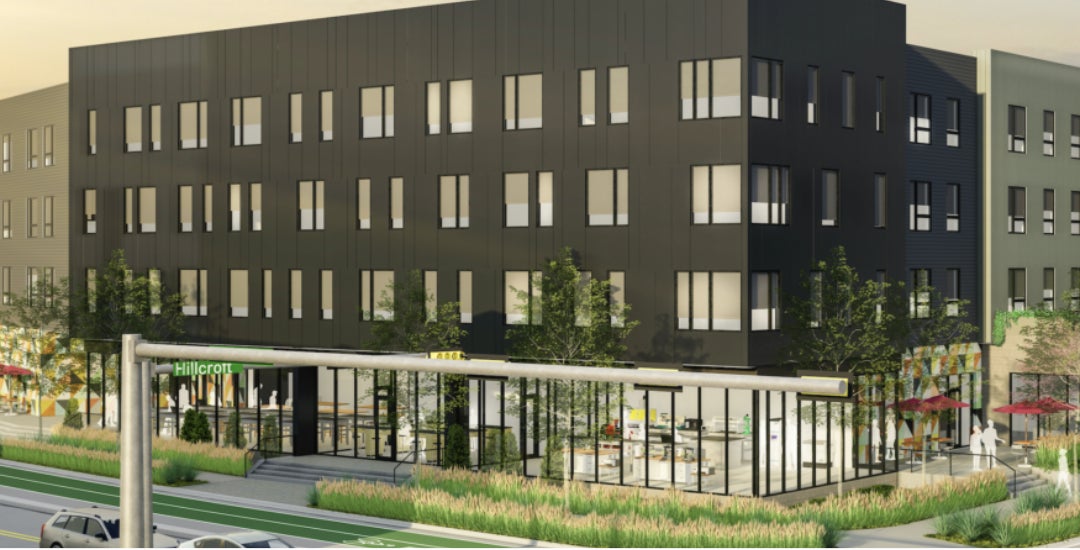Seeking Solutions is a special editorial series by the Kinder Institute’s Urban Edge highlighting the people, organizations and initiatives bringing positive change to communities in the Greater Houston region.
The nonprofit organization uses four pillars to guide its work — education, health and wellness, economic vitality and affordable housing. Connect Community is the result of a partnership between KIPP Texas Public Schools, Legacy Community Health, St. Luke’s United Methodist Church and the YMCA.
Connect Community typically serves immigrants who are asylees or refugees, also referred to as newcomers. Its leadership said 38% of the population in its service area is under 18, and there are 26 schools in a two-mile radius.
“We really believe that the youth is our strength and the youth is our future,” said Anne Whitlock, Connect Community’s founding director. “Everybody comes from someplace else, so communication is probably our biggest challenge.”
Education: Overcoming language barriers
Of the schools in Connect Community’s impact zone, two specifically serve newcomer students. The Houston Independent School District’s Las Americas Newcomer School serves fourth- to eighth-grade students, and Liberty High School enrolls students who are of high school age or older.
Recent Kinder Institute research indicated that Las Americas students were predominantly from Central American and sub-Saharan African countries, and had lower levels of English proficiency. However, by the time they took end-of-course exams their English had improved. Students at Liberty performed similarly to newcomers enrolled at non-newcomer schools, including in English proficiency.
When Connect Community created a community of practice of local school leaders from non-newcomer schools, the most common feedback was the need for communication between parents, students and teachers, including rapid English language transition. This prompted the launch of Connect Community’s translator program with AmeriCorps in 2023.
After having translators at seven schools last year, they will be at nine campuses in the spring 2024 semester serving about 470 bilingual students. The program has translators who speak Arabic, Dari and Pashto, which are spoken in Afghanistan; Farsi; Urdu, the national language of Pakistan; and Spanish.
“The response so far has been overwhelmingly positive from the schools,” said Caleb Kurowski, director of the AmeriCorps translator program. “We have stories from parents being really appreciative of the translators being there because it’s an in. If you don’t speak English and someone is there who can translate your needs, it really helps them connect with the school, and of course for students as well who are struggling in the classroom.”
English language and other educational skills are urgent for newcomer adults in Gulfton and Sharpstown as well, but not as accessible. Connect Community hopes to expand its capacity for adult language learning and digital and financial literacy this year.
“There’s such a need for ESL classes in these neighborhoods, and there’s waitlists upon waitlists,” said Lauren Caldarera, Connect Community’s director of economic vitality initiatives. “We need to solve that so people can get the English classes they need in order to be successful in their lives here. If they’re having to wait six or 12 months to get into a class, that’s a whole year wasted.”
Health & Wellness: Greening the neighborhood
Adding greenspace and creating safer thoroughfares are among Connect Community’s priorities for its health and wellness pillar. In a heat mapping campaign conducted by The Nature Conservancy and the Houston Advanced Research Center, Gulfton was measured as the hottest neighborhood in Houston.
To continue greening efforts, Whitlock said Trees for Houston will site and plant 800 trees this spring, and mechanical shade structures have been developed for spaces that do not allow tree growth. Additional efforts include the Gulfton Safe Streets mural to increase pedestrian visibility at the busy intersection of High Star Drive, Westward Street and Hillcroft Avenue.
Photo courtesy Houston Public Works
“The streets in this area are very wide and very fast,” Whitlock said. “We’ve had a lot of kids hit, and a few have been killed. Since this is a newcomer neighborhood, we’re just trying to build awareness. There are a lot of people walking, and a lot of people who don’t have licenses who are driving. With the 26 nearby schools, it creates this perfect storm of danger.”
Economic vitality: Creating paths to careers
Connect Community might be most recognized for its HTX Sewn Goods textile lab initiative. Established during the COVID-19 pandemic, it produced about 75,000 masks that were sold in Houston and elsewhere.
“We knew that women in the neighborhood came with sewing skills, and we knew that we could train them to make masks,” Whitlock said. “We did Zoom training in five different languages, and placed five sewing machines in their homes. Since that was their first entrée into the work world, they were like, ‘Well, what’s next?’”
HTX Sewn Goods saw an increase in business after receiving inquiries from designers and entrepreneurs who had an idea or product but lacked the labor source to make it — otherwise known as white label production.
“Now, we’re working at any one time with over 30 designers to make their products,” Whitlock said. “We just graduated our fourth cohort of trainees through a nine-month program. Many newcomers come here and they don’t want to leave their neighborhood. We give them an opportunity to work in our production space until they gain more confidence. We placed 15 people last year with different cut-and-sew shops and awning shops.”
Affordable housing: Decades in the making
The first floor of Connect Community’s first multifamily housing development at Hillcroft and High Star will feature a 9,000-square-foot textile lab with a production space, training space and a computer classroom. Construction on the 77-unit Connect South apartment complex is expected to be completed by the end of 2024. Connect Community leadership said the facility represents the first new build in Gulfton in over 40 years.
Photo courtesy Alley Poyner Macchietto Architecture
Commonly referred to as a modern-day Ellis Island, Gulfton has a density of over 16,000 people per square mile, according to the city of Houston’s Planning and Development Department. Neighboring Sharpstown has over 9,000 people per square mile. With many immigrants making these parts of southwest Houston their first stop in the U.S., Connect Community leaders said the lack of social services and a culture of self-sufficiency can be a shock for many.
“It’s still that ‘pull yourself up by your bootstraps’ mentality,” Caldarera said. “Part of it is our responsibility to start having conversations and stressing that their lives are different here. They have opportunities and they need to start thinking about their future selves. It’s not something that’s getting nurtured enough.”





